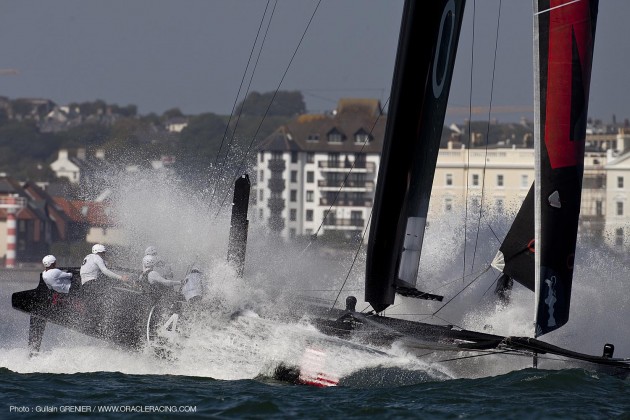The AC World Series committee boat provided a spectacular vantage point for an incredible day’s racing
Standing on the upper deck of the committee boat during yesterday’s outstanding race was an eye opener. Aside from the spectacular view from the upper deck 15ft above the water, Sunday’s breezy scene was unlike anything I’ve witnessed before.
At first there was nothing particularly different to any other busy pre-start area as competitors sniffed the stiff breeze, practiced their beats and runs, hoists, gybes and drops. There were timed runs into the line and plenty of spins up into the breeze to pause and check the conditions.
Yet the pace at which all this and more was happening was mildly disorientating.
When an AC45 makes a practice timed run into the committee boat end of the line in 20-27 knots of breeze, it does so at 20 knots plus. As each of them whistled past the committee boat’s transom with what looked like inches to spare, you could hear the high pitched whistle of the foils as they passed and almost feel the vacuum in their wake as if you were standing on a railway platform as an express train barrels through.
At one point Loic Peyron on the French Energy Team came through flying a hull so high that our eyes seemed to meet at the same level as the windward hull appeared to pass up and over our aft quarter.
Helicopters screeched around the pre-start area at what felt like just a few feet above us, while jet skis and RIBS scorched around like snowboarders on a black run as the sea was whipped up into a foaming frenzy. Our entire world seemed to be running on fast forward with a battlefield soundtrack to match as the stiff breeze flogged the various signal flags, including a giant chequered start flag so violently that it sounded like a group of Harley Davidson motorbikes were buzzing the committee boat.
Above the background din, various radio calls were being made between mark boats and competitors, the VHF radios turned up to what felt like full volume. How course marshal Harold Bennett could hear anything above the noise, let alone respond, was beyond me.
From time to time deputy Queens Harbour Master Richard Smith stepped out onto the aft deck to take or make a phone call to his colleagues ashore as they managed the commercial traffic that was scheduled to enter the busy harbour.
Meanwhile, in the relative calm of the wheelhouse, principal race officer John Craig was surrounded by computer screens and specialist staff as they plotted the intricate race course within Plymouth Sound and co-ordinated the mark boat movements.
And all the while the large digital clock counted down the minutes to the start.
When the time came, the nine eager AC45’s and their crews put their pedals to the metal and scorched off on a 30 second reaching leg to the first mark in a collective ball of spray with dead straight white wakes streaming out behind. You could easily have mistaken the picture for the start of the Cowes Torquay powerboat race had it not been for the tall wing masts.
Thirty seconds later it felt like the pause and mute buttons on our world had been pressed simultaneously. The heat of battle was now playing out on the far side of the course, no one was interested in our patch of water. All that was left was some big grins and wide eyes among those whose duties had been performed.
The respite was short lived as several boats came perilously close to capsizing or spinning out as they struggled to manoeuvre through the dangerous downwind zones that can trip and flip a racing cat like a paper bag in a windy alley.
After several close calls it was Aleph that was the first capsize. As the collective oooooohs died down among the race management team as the French boat’s mast hit the water, the busy VHF chatter started as Bennett helped to establish whether all the crew were OK
and co-ordinate the rescue boats. The first of three such incidents.
For me the day was a complete eye opener and proved that the drama and excitement of this new style of racing isn’t just reserved for the crews.




